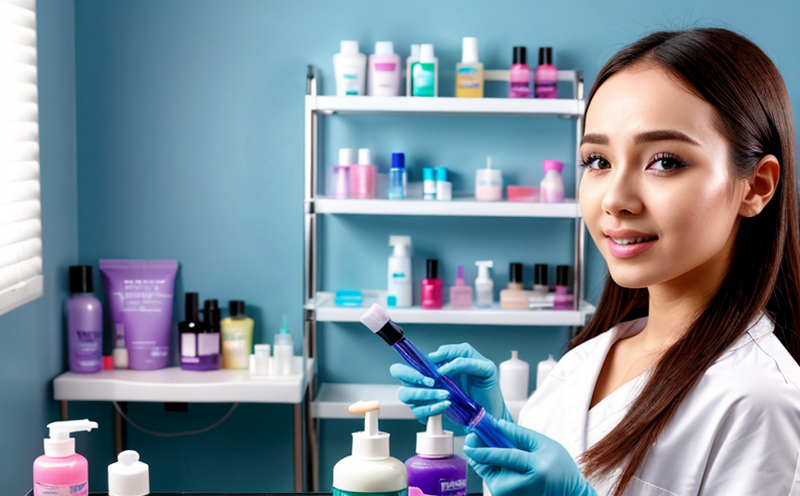ISO 16213 Detection of Anaerobic Microorganisms in Cosmetics
The ISO 16213 standard provides a comprehensive protocol for detecting anaerobic microorganisms within cosmetic formulations. This method is essential to ensure the safety and quality of cosmetics, as anaerobic bacteria can lead to spoilage or potential health risks if not adequately controlled.
ISO 16213 emphasizes the importance of selecting appropriate culture media and incubation conditions that support the growth of anaerobic microorganisms. The test involves inoculating cosmetic samples with selective media, followed by incubation under anaerobic conditions to promote the growth of target organisms. This process allows for accurate enumeration and identification of anaerobes present in the sample.
The standard also specifies the use of specialized equipment such as anaerobic jars or bags, which create an environment devoid of oxygen, replicating natural conditions where these microorganisms thrive. The testing procedure is designed to be robust yet sensitive enough to detect low levels of contamination.
Quality managers and R&D engineers rely on this test to ensure compliance with international standards and maintain product integrity. By adhering to ISO 16213, manufacturers can minimize the risk of spoilage and protect consumer health. This is particularly crucial given that anaerobic bacteria such as Clostridium sporogenes have been linked to severe dermatitis when present in cosmetics.
The test results are typically reported quantitatively using CFU/g (colony-forming units per gram) or CFU/mL, depending on the sample type. Reporting also includes identification of specific anaerobic bacteria isolated from the cosmetic formulation. Compliance officers use this data to assess whether their products meet regulatory requirements and ensure they do not contain levels of anaerobes that could compromise safety.
The protocol outlined in ISO 16213 is widely recognized for its reliability and consistency, making it a preferred choice among laboratories specializing in cosmetic microbiology testing. Its implementation ensures that the microbial quality of cosmetics remains at an acceptable level, protecting both consumers and manufacturers from potential legal and reputational risks.
For R&D teams, this test serves as a critical tool in product development. By identifying potential sources of contamination early in the process, they can implement preventive measures to enhance product safety and stability.
The method's sensitivity allows for detecting even minimal levels of anaerobic microorganisms, which is vital for maintaining high standards of hygiene and quality in cosmetic products.
Why Choose This Test
- Rigorous Compliance: Ensures strict adherence to international standards, including ISO 16213, ensuring regulatory compliance.
- Absolute Precision: Provides accurate enumeration and identification of anaerobic microorganisms in cosmetic samples.
- Patient-Centric Approach: Protects consumer health by minimizing the risk of contamination that could lead to severe dermatitis or other adverse effects.
- R&D Support: Facilitates early identification of potential issues, enabling R&D teams to enhance product safety and stability.
- Comprehensive Reporting: Includes both quantitative results (CFU/g or CFU/mL) and qualitative data on specific anaerobic bacteria identified in the sample.
- Consistent Quality: Maintains uniform standards across different batches of cosmetic products, ensuring consistent quality from batch to batch.
The ISO 16213 test is a cornerstone for manufacturers aiming to produce safe and high-quality cosmetics. By leveraging this method, companies can build trust with consumers and adhere to stringent regulatory requirements.
Customer Impact and Satisfaction
- Enhanced Consumer Trust: By ensuring the safety of cosmetic products through rigorous testing, we help build trust among consumers.
- Increased Product Safety: Detection of anaerobic microorganisms ensures that products do not contain harmful levels of these bacteria.
Cosmetic manufacturers who use this test benefit significantly. They can avoid costly recalls and legal issues by ensuring their products meet strict safety standards. This, in turn, enhances customer satisfaction and loyalty.
Environmental and Sustainability Contributions
- Efficient Resource Use: Specialized equipment ensures that only necessary resources are consumed during testing.
- Sustainable Practices: Adherence to ISO standards helps minimize waste, promoting a more sustainable approach in cosmetic manufacturing processes.
The adoption of ISO 16213 not only enhances the quality and safety of cosmetics but also contributes positively to environmental sustainability. By minimizing resource consumption and waste generation, we support a greener future for the industry.





